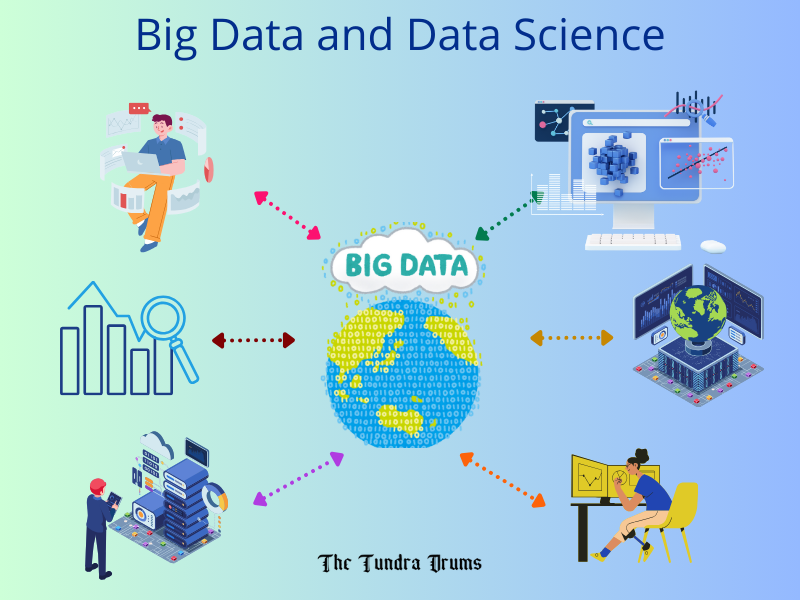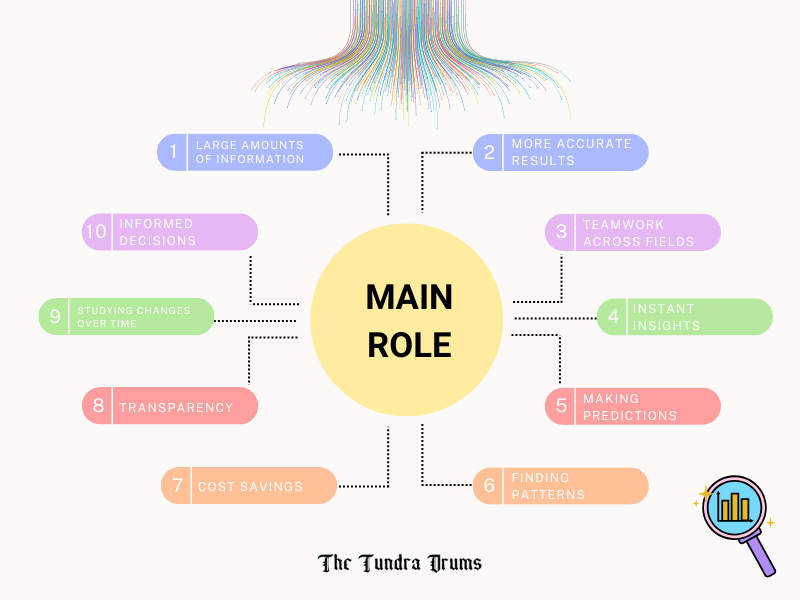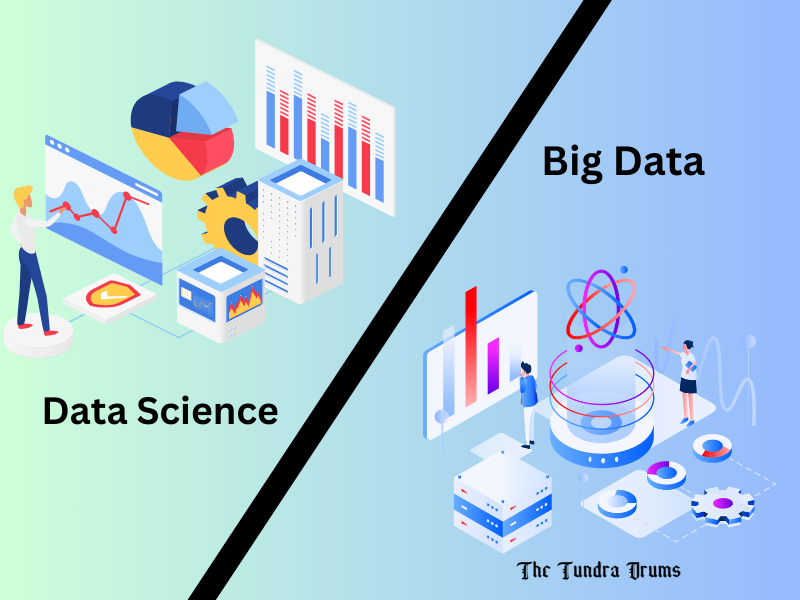Big Data and Data Science are transforming the way we do scientific research. These powerful tools help researchers handle huge amounts of information, work more efficiently, and make more accurate predictions. Whether it’s improving healthcare, speeding up discoveries, or assisting scientists to collaborate across the globe, Big Data is opening up new possibilities in research. In this article, you will explore how Big Data makes a real difference in science and why it’s important for future research.

Big Data
- This refers to extremely large data sets that are too complex to process using traditional methods.
- Comes from sources like social media, sensors, websites, and more.
- Helps businesses and researchers find patterns, trends, and insights from vast amounts of information.
Data Science
- A field that uses tools, techniques, and algorithms to analyze and make sense of Big Data.
- Combines skills from math, statistics, and computer science.
- Helps solve complex problems, make predictions, and guide decisions in various industries.
Importance of Big Data in Scientific Research

Big data plays a crucial role in scientific research today. Here are some reasons why it’s important:
- Large Amounts of Information: Big data allows scientists to work with huge sets of information from many different sources. This helps them understand complex issues better, including fields like nanotechnology, where precise measurements at the nanoscale are essential for developing new materials and applications.
- More Accurate Results: Analyzing large amounts of data leads to more precise measurements, which means more reliable results. This is especially important in fields like medicine and environmental studies.
- Teamwork Across Fields: Big data encourages scientists from different areas to work together. This teamwork can spark new ideas and improve research methods.
- Instant Insights: Researchers can analyze data as it comes in, allowing them to change their experiments and respond to new trends faster quickly.
- Making Predictions: Big data helps scientists create models that predict future events or trends. This is especially useful in healthcare for preventing diseases.
- Finding Patterns: Looking at large datasets helps researchers spot patterns that might not be visible in smaller samples. This can lead to discoveries.
- Cost Savings: Using big data can be cheaper than collecting new data. Researchers can analyze existing datasets, saving time and money.
- Transparency: Big data makes research findings available to the public. This openness helps build trust in science and allows people to get involved in research.
- Studying Changes Over Time: Big data enables long-term studies that show how things change over time, giving a deeper understanding of trends.
- Informed Decisions: Big data helps scientists make decisions based on solid evidence, leading to better conclusions and recommendations.
Key Applications of Data Science in Research

1. Predictive Analytics:
Data science helps scientists predict what might happen in the future by looking at past information. For example, it can forecast health issues or the spread of diseases. This helps researchers prepare better.
2. Natural Language Processing (NLP):
NLP allows researchers to understand and analyze large amounts of written text. They can find important topics and trends in articles or social media posts. This helps them gather insights from public opinions.
3. Image and Signal Processing:
Data science techniques examine images and signals, like X-rays or satellite photos. This can help detect problems, such as tumors in medical images. It makes it easier to spot things that need attention.
4. Machine Learning:
Machine learning allows computers to learn from data and make decisions independently. Researchers can use it to sort information or find hidden patterns in large datasets. This improves the accuracy of their results.
5. Bioinformatics:
In biology, data science helps analyze complex biological data, like DNA sequences. This can lead to a better understanding of diseases and new treatments. It connects biology with technology to advance healthcare.
6. Social Network Analysis:
Researchers study how people connect and interact on social media. This helps them understand how information spreads among groups. It reveals important social dynamics and influences.
7. Experimental Design and Analysis:
Data science supports researchers in planning experiments and understanding their results. By analyzing data carefully, they can make better conclusions. This helps improve future studies.
8. Big Data Analytics:
Big data tools help scientists manage and analyze huge amounts of information. This allows them to uncover insights that smaller datasets might miss. It opens up new research opportunities.
9. Geospatial Analysis:
Data science is used to study geographic information, like maps and locations. Researchers can analyze patterns related to climate change or city growth. This helps in planning and decision-making.
10. Survey and Feedback Analysis:
Data science techniques help analyze responses from surveys to understand people’s opinions. This can inform policies and improve services. It gives a voice to the community through data.
Impacts of Big Data and Data Science in Scientific Research

Big Data isn’t just for tech companies. It’s transforming industries and changing the way we understand and improve the world around us. This approach is changing how we do scientific research in exciting and powerful ways. They’re helping researchers work faster, with more accuracy, and even opening up new paths of discovery. Here are some of the most significant impacts:
– Faster Research:
The world is expected to generate 175 zettabytes of data by 2025, which gives researchers more information than ever before to work with. Using Big Data techniques, researchers can cut down the time they spend gathering and analyzing data by up to 80%. This allows them to focus more on the data’s meaning and how it can be applied.
– More Accurate Predictions:
When researchers combine different datasets, they can improve the accuracy of their findings by up to 30%. In areas like genomics, for example, machine learning tools have boosted the ability to predict disease outcomes by more than 20%. This is making science more reliable and precise.
– Better Collaboration:
The push for open data has increased the number of shared datasets by 300% since 2010, helping researchers from all over the world collaborate more easily. This openness is driving innovation across various scientific fields. Plus, funding for Big Data projects has grown by about 50% annually, showing that these tools are now recognized as crucial for research.
– Real-World Success:
Big Data is making a difference in real-world cases. For example, Walmart processes 2.5 petabytes of data every hour to improve its supply chain and customer experience. Hospitals that use big data have seen up to a 15% improvement in patient outcomes.
Challenges Faced in Utilizing Big Data
- Inaccurate or incomplete data can lead to wrong conclusions. If the data you collect has mistakes or is missing key details, your research results might not be reliable.
- Protecting personal information is a big concern. When you’re working with big data, you often handle sensitive information, so keeping that data secure is important to respect people’s privacy.
- Storing large data sets can get expensive. As your data grows, the costs for storage like servers or cloud services can add up, making it a financial challenge for your organization.
- Many researchers lack the skills to analyze big data. The tools and techniques needed can be complex, and not everyone has the training to use them effectively, limiting what you can learn from the data.
- Combining data from different sources can be tricky. If you’re pulling data from various places, ensuring everything fits together correctly can be challenging, especially when the formats don’t match.
- Managing too much data can feel overwhelming. When you have a lot of information, it can be hard to know where to start or how to find the most important insights.
- Following data laws and regulations can be complicated. There are many rules about how data should be used, and keeping track of these regulations is essential to avoid legal issues.
- Good technology and infrastructure are needed, but they can be costly. To analyze big data effectively, you need powerful computers and software, which can take time and money to set up and maintain.
Case Studies: Successful Use of Data Science in Research

1. Personalized Marketing at Amazon
- Challenge: Amazon wanted to boost user engagement by offering tailored product recommendations.
- Solution: They implemented a collaborative filtering algorithm that looks at user purchase history, ratings, and behavior to suggest products users will likely enjoy.
- Impact: This approach significantly increased customer satisfaction and sales conversions, showing the power of data-driven marketing strategies.
2. Predictive Healthcare at Mayo Clinic
- Challenge: The Mayo Clinic aimed to enhance patient outcomes by predicting health issues before they became serious.
- Solution: They used predictive analytics to analyze past patient records and real-time health data, creating models to identify patients at risk for diabetes and heart disease.
- Impact: This initiative improved patient outcomes through timely interventions and reduced healthcare costs by preventing diseases from worsening.
3. Predictive Maintenance at General Electric (GE)
- Challenge: GE needed to optimize its manufacturing processes to lower costs and reduce downtime.
- Solution: They used machine sensor data to predict when maintenance would be needed, allowing for proactive repairs.
- Impact: This strategy led to a significant decrease in unexpected machine downtime and lower maintenance costs, improving overall operational efficiency.
4. Tsunami Early Warning System at Stanford University
- Challenge: Researchers aimed to create an effective early warning system for tsunamis.
- Solution: They employed machine learning algorithms to enhance the accuracy of tsunami predictions by analyzing various environmental factors.
- Impact: The improved warning system helps communities prepare for potential disasters, demonstrating the value of data science in geosciences and disaster management.
5. Walmart’s Data Utilization
- Challenge: Walmart wanted to optimize its supply chain and improve customer experiences.
- Solution: They analyze vast customer data to personalize shopping experiences and manage inventory more effectively.
- Impact: Walmart processes about 2.5 petabytes of data every hour, leading to increased sales and better operational efficiency through data-driven decision-making.
Future Trends in Big Data and Scientific Research

By 2025, 90% of new enterprise applications will be expected to include artificial intelligence (AI) capabilities, marking a significant shift toward using advanced analytics to gain insights from big data.
Additionally, the demand for real-time analytics is projected to rise sharply, with the market expected to reach $33.5 billion by 2026, highlighting the need for immediate insights across various industries.
As of 2022, 94% of enterprises are utilizing cloud services, which allow for more efficient and cost-effective storage and processing of large datasets, further driving the adoption of big data solutions.
Concerns about data privacy are also prominent, with 83% of consumers worried about how their data is used. This has prompted organizations to focus on ethical data practices and transparency in their strategies.
Furthermore, integrating advanced technologies like blockchain and augmented reality (AR) with big data will enhance data security and provide innovative ways to visualize information. The AR market alone is projected to grow to $198 billion by 2025, indicating a strong trend toward immersive data experiences.
With the rise of the Internet of Things (IoT), decentralized data processing methods are becoming more important. By 2025, there will be over 75 billion connected devices worldwide, making efficient decentralized data management solutions essential.
Conclusion
Big data and data science are revolutionizing scientific research by providing powerful tools for analysis and collaboration. These advancements lead to faster discoveries, more accurate predictions, and improved outcomes in various fields. As technology continues to evolve, the potential for future research is limitless and exciting.











